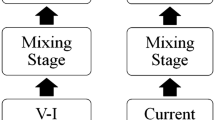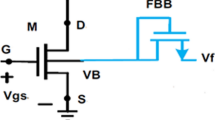Abstract
As the 5G era beckons in the world of communication and information technology, there is a surge in demand for battery-operated, mobile wireless devices. These wireless devices which are part of the Internet-of-Things (IoT) framework are required to process data with at most accuracy. With sub-6 GHz 5G networks, the IoT systems must be able to withstand large interferers in order to maintain the fidelity of the message signal. Therefore, the linearity of the analog circuits is inevitably crucial for 5G networks. Thus, analog circuits with high linearity at reduced power consumption is the present-day challenge for implementing battery-powered 5G applications. To address the growing market demand for battery-powered wireless devices, this work proposes an ultra-low-power RF mixer with enhanced linearity suitable for sub-6 GHz 5G applications. The post-layout simulations indicate an IIP3 of 8.63dBm while the conversion gain and double-sideband noise figure (DSB-NF) are 9.5 dB and 12.26 dB respectively at 2.4 GHz. The proposed mixer sources 223.3 \(\mu\)A from a 1 V power supply. The proposed circuit is characterized by process-voltage-temperature variations, random process and device mismatches, and also for local oscillator feedthrough.




























Similar content being viewed by others
Data availability statement
Data sharing not applicable to this article as no datasets were generated or analysed during the current study.
References
Mattisson, S. (2018). An overview of 5G requirements and future wireless networks. IEEE Solid State Circuits Magazine, 10(3), 54–60.
Parvizi, M., & Nabavi, A. (2010). Low-power highly linear UWB CMOS mixer with simultaneous second- and third-order distortion cancellation. Microelectronics Journal, 41, 1–8.
Solati, P., & Yavari, M. (2019). A wideband high linearity and low-noise CMOS active mixer using the derivative superposition and noise cancellation techniques. Circuits, Systems, and Signal Processing, 38, 2910–2930.
Lin, H., Lin, Y., & Wang, H. (2018). A high linearity 24-GHz down-conversion mixer using distributed derivative superposition technique in 0.18-μ m CMOS process. IEEE Microwave and Wireless Components Letters, 28(1), 49–51.
Shi, L. X., Chen, C., Wu, J. H., & Zhang, M. (2012). A 1.5-V current mirror double-balanced mixer with 10-dBm IIP3 and 9.5-dB conversion gain. IEEE Transactions on Circuits and Systems-II: Express Briefs, 99(4), 204–208.
Ma, L., Wang, Z., & Xu, J. (2017). ‘A 1-V current-reused wideband current-mirror mixer in 180-nm CMOS with high IIP2. Circuits, Systems, and Signal Processing, 36, 1806–1817.
Huang, W., Huang, I., Tseng, Y., Hsieh, C., & Wang, C. (2017). A 19.38 dBm OIP3 gm-boosted up-conversion CMOS mixer for 5–6 GHz application. Microelectronics Journal, 60, 38–44.
Chong, W. K., Ramiah, H., & Vitee, N. (2015). A 0.12-mm2 2.4-GHz CMOS inductorless high isolation subharmonic mixer with effective current-reuse transconductance. IEEE Transactions on Microwave Theory and Techniques, 63(8), 2427–2437.
Wan, Q., Wang, C., & Sun, J. (2013). Design of a low voltage highly linear 2.4 GHz up-conversion mixer in 0.18 μ m CMOS technology. Wireless Personal Communication, 70, 57–68.
Zhao, L., & Wang, C. (2015). A novel low voltage low power high linearity self-biasing current-reuse up-conversion mixer. Wireless Personal Communication, 80, 277–287.
Bhatt, D., Mukherjee, J., & Redouté, J. (2017). ‘A self-biased mixer in 0.18- m CMOS for an ultra-wideband receiver. IEEE Transactions on Microwave Theory and Techniques, 65(4), 1294–1302.
Chen, J. (2011). A low-voltage high-linearity ultra-wideband down-conversion mixer in 0.18-μ m CMOS technology. Microelectronics Journal, 42, 113–126.
Mollaalipour, M., & Miar-Naimi, H. (2013). An improved high linearity active CMOS mixer: design and volterra series analysis. IEEE Transactions on Circuits and Systems-I: Regular Papers, 60(8), 2092–2103.
Mollaalipour, M., & Miar-Naimi, H. (2016). ‘Design and analysis of a highly efficient linearized CMOS subharmonic mixer for zero and low-IF applications. IEEE Transactions on Very Large Scale Integration (VLSI) Systems, 24(6), 2275–2285.
Mohsenpour, M., & Saavedra, C. E. (2016). Method to improve the linearity of active commutating mixers using dynamic current injection. IEEE Transactions on Microwave Theory and Techniques, 64(12), 4624–4631.
Kim, M., & Yun, T. (2014). Analysis and design of feedforward linearity-improved mixer using inductive source degeneration. IEEE Transactions on Microwave Theory and Techniques, 62(2), 323–331.
Chang, C., & Onbajo, M. (2013). IIP3 enhancement of subthreshold active mixers. IEEE Transactions on Circuits and Systems-II: Express Briefs, 60(11), 731–735.
Asghari, M., & Yavari, M. (2016). An IIP3 enhancement technique for CMOS active mixers with a source-degenerated transconductance stage. Microelectronics Journal, 50, 44–49.
Jin, J. (2017). Resonant amplifier-based sub-harmonic mixer for zero-IF transceiver applications. Integration, the VLSI journal, 57, 69–73.
Neda, S., & Nabavi, A. (2017). Design of an active CMOS subharmonic mixer with enhanced transconductance. International Journal of Electronics and Communications, 73, 98–104.
Wan, Q., Xu, D., Zhou, H., & Dong, J. (2018). ‘A complementary current-mirror-based bulk-driven down-conversion mixer for wideband applications. Circuits, Systems, and Signal Processing, 37, 3671–3684.
Bijari, A., & Zandian, S. (2019). Linearity improvement in a CMOS down-conversion active mixer for WLAN applications. Analog Integrated Circuits and Signal Processing, 100, 483–493.
Li, H., & Saavedra, C. E. (2019). Linearization of active downconversion mixers at the IF using feedforward cancellation. IEEE Transactions on Circuits and Systems-I: Regular Papers, 66(4), 1620–1631.
Tsai, J., Xiao, H., Cheng, J., & Chang, R. (2018). Ultra-low-LO-power X-band down-conversion ring mixer using weak-inversion biasing technique. Electronics Letters, 54(3), 130–132.
Darabi, H., & Abidi, A. A. (2000). Noise in RF-CMOS mixers: a simple physical model. IEEE Transactions on Solid State Circuits, 35(1), 15–25.
Terrovitis, M. T., Kundert, K. S., & Meyer, R. G. (2002). Cyclostationary noise in radio-frequency communication systems. IEEE Transactions on Circuits and Systems-I: Fundamental Theory and Applications, 49(11), 1666–1671.
Gladson, S. C., Vijayalakshmi, S., Lakshmi, M. S., & Bhaskar, M. (2019). Linearity improvement of RF mixer using double-linearization for 5 GHz applications. International Journal of Electronics and Communications, 110, 1–14.
Acknowledgements
The authors would like to thank the Ministry of Electronics and Information Technology (MeiTy), Govt. of India for supporting this research work under the Visvesvaraya PhD scheme with Grant No. VIS-PHD-1708.
Author information
Authors and Affiliations
Corresponding author
Additional information
Publisher's Note
Springer Nature remains neutral with regard to jurisdictional claims in published maps and institutional affiliations.
Rights and permissions
About this article
Cite this article
Gladson, S.C., Prasad, P.S. & Manickam, B. A 223-\(\mu W\) single-to-differential RF mixer with 8.6dBm IIP3 using current-bleeding and body-effect for sub-6 GHz 5G applications. Analog Integr Circ Sig Process 109, 571–583 (2021). https://doi.org/10.1007/s10470-021-01942-8
Received:
Revised:
Accepted:
Published:
Issue Date:
DOI: https://doi.org/10.1007/s10470-021-01942-8




